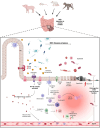Immunological aspects of necrotizing enterocolitis models: a review
- PMID: 39104529
- PMCID: PMC11298363
- DOI: 10.3389/fimmu.2024.1434281
Immunological aspects of necrotizing enterocolitis models: a review
Abstract
Necrotizing enterocolitis (NEC) is one of the most devasting diseases affecting preterm neonates. However, despite a lot of research, NEC's pathogenesis remains unclear. It is known that the pathogenesis is a multifactorial process, including (1) a pathological microbiome with abnormal bacterial colonization, (2) an immature immune system, (3) enteral feeding, (3) an impairment of microcirculation, and (4) possibly ischemia-reperfusion damage to the intestine. Overall, the immaturity of the mucosal barrier and the increased expression of Toll-like receptor 4 (TLR4) within the intestinal epithelium result in an intestinal hyperinflammation reaction. Concurrently, a deficiency in counter-regulatory mediators can be seen. The sum of these processes can ultimately result in intestinal necrosis leading to very high mortality rates of the affected neonates. In the last decade no substantial advances in the treatment of NEC have been made. Thus, NEC animal models as well as in vitro models have been employed to better understand NEC's pathogenesis on a cellular and molecular level. This review will highlight the different models currently in use to study immunological aspects of NEC.
Keywords: animal models; immune cells; immune system; necrotizing enterocolitis; organoids.
Copyright © 2024 Blum, Vincent, Boettcher and Knopf.
Conflict of interest statement
The authors declare that the research was conducted in the absence of any commercial or financial relationships that could be construed as a potential conflict of interest.
Figures

References
Publication types
MeSH terms
Substances
LinkOut - more resources
Full Text Sources

